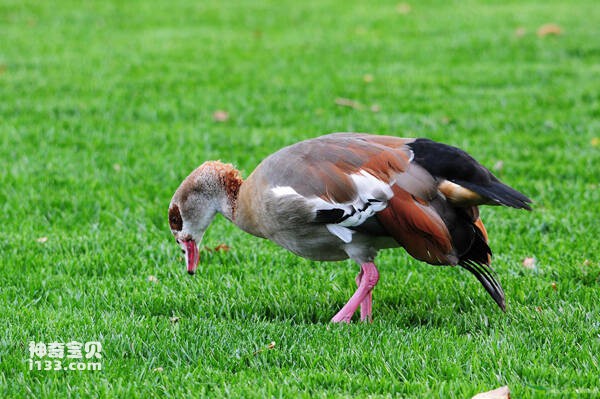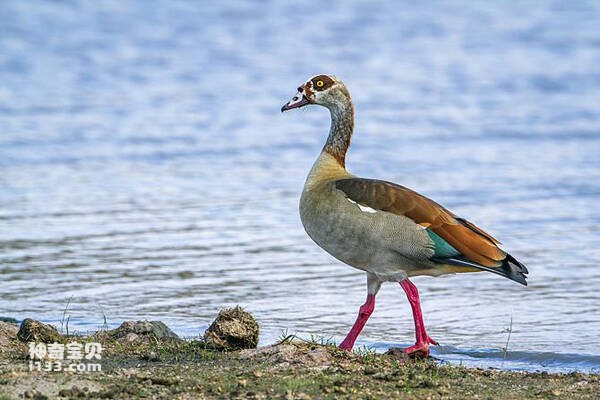Alopochen aegyptiacus
IUCN
LCBasic Information
Scientific classification
- name:Alopochen aegyptiacus
- Scientific Name:Alopochen aegyptiacus,Egyptian Goose
- Outline:Waterfowl
- Family:
Vital signs
- length:63-73cm
- Weight:1.5-2.5kg
- lifetime:No textual research information is available
Feature
The eyes are brown, with a pair of red circles around the eye socket that look like wearing sunglasses, and the neck and back feathers are chocolate
Distribution and Habitat
It is distributed in Angola, Botswana, Burkina Faso, Burundi, Cameroon, Central African Republic, Chad, Democratic Republic of the Congo, Djibouti, Egypt, Equatorial Guinea, Eritrea, Ethiopia, Gabon, Gambia, Guinea, Guinea-Bissau, Kenya, Lesotho, Malawi, Mali, Mauritania, Mozambique, Namibia, Niger, Nigeria, Rwanda, Senegal, Somalia, South Africa, South Sudan, Sudan, Eswatini, United Republic of Tanzania, Tunisia, Uganda, Zambia and Zimbabwe.
Regional extinction: Israel.
Occasional entries: Austria, Belgium, Denmark, Netherlands, United Arab Emirates, United Kingdom.
Travellers: Algeria, Benin, China, Cote d 'Ivoire, Cyprus, France, Ghana, Hungary, Malta, Oman, Spain, Togo.
Origin unknown: Qatar.
Appearance
The goose is 63-73 cm long, weighs 1.5-2.5 kg and has a wingspan of 134-154 cm. The eyes are brown, the eye socket has a pair of red eye circles like wearing sunglasses, the neck and back feathers are chocolate color, a pair of good at flying large wings are composed of arranged black and white, there are long pink feet, the mouth base beige. The upper body is slightly mottled reddish-brown, and the neck has a reddish-brown collar. The upper and upper corners, chest, and almost all of the lower parts are yellowish-gray, and the sides are light beige. White belly to chocolate brown spots on chest. Lower back and shoulders brownish gray, also some reddish-brown. Back, rump and tail black. The elytra is covered with white and bordered by dark lines along the main flight feathers. The flight and tail feathers are black, the primary and secondary feathers are metallic green or Burgundy, and the base of the tertiary feathers is white. Bright red and flat sharp mouth, with a pair of good swim
Details
Egyptian Goose (Alopochen aegyptiacus), no subspecies.

Egyptian wild goose is a fierce type of water bird with strong territorial nature. In addition to the fierce call, small ducks that invade the field are often attacked by it. The social water birds usually appear in pairs and are active in the wide grassland during the day, living the life of early morning and evening. But the night reveals its homely habits; Return to the same spot for the night.
Egyptian geese usually graze on land, including a variety of plants, feeding on grass, seeds, shoots, leaves, grains, and crops. They also forage from shallow water, including algae and aquatic plants, and sometimes eat animal matter such as worms, locusts, or termites.

Egyptian geese tend to pair with the same species. When seeking a mate, the female birds take the initiative to tempt the male birds with all their charm. Social males, on the other hand, must rely on force to decide the right to mate. After pairing, the male and female form and choose the site of the nest. The nest is made of materials collected in the surrounding environment, and is lined with soft feathers.
Listed on the International Union for Conservation of Nature Red List of Threatened Species (IUCN) 2018 ver 3.1 - Not Threatened (LC).
Protect wild animals and eliminate wild meat.
Maintaining ecological balance is everyone's responsibility!
Egyptian Goose (Alopochen aegyptiacus), no subspecies.

Egyptian wild goose is a fierce type of water bird with strong territorial nature. In addition to the fierce call, small ducks that invade the field are often attacked by it. The social water birds usually appear in pairs and are active in the wide grassland during the day, living the life of early morning and evening. But the night reveals its homely habits; Return to the same spot for the night.
Egyptian geese usually graze on land, including a variety of plants, feeding on grass, seeds, shoots, leaves, grains, and crops. They also forage from shallow water, including algae and aquatic plants, and sometimes eat animal matter such as worms, locusts, or termites.

Egyptian geese tend to pair with the same species. When seeking a mate, the female birds take the initiative to tempt the male birds with all their charm. Social males, on the other hand, must rely on force to decide the right to mate. After pairing, the male and female form and choose the site of the nest. The nest is made of materials collected in the surrounding environment, and is lined with soft feathers.
Listed on the International Union for Conservation of Nature Red List of Threatened Species (IUCN) 2018 ver 3.1 - Not Threatened (LC).
Protect wild animals and eliminate wild meat.
Maintaining ecological balance is everyone's responsibility!








